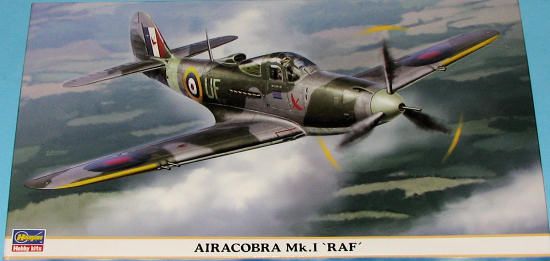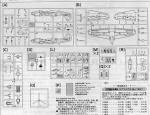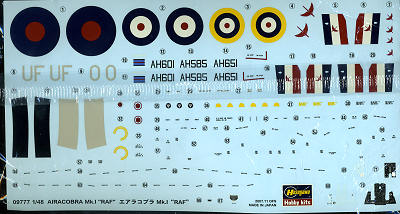
Hasegawa 1/48 Airacobra Mk.I 'RAF'
| KIT: | Hasegawa 1/48 Airacobra Mk.I 'RAF' |
| KIT #: | 09777 |
| PRICE: | $29.60 at www.greatmodels.com |
| DECALS: | Three options (actually three different serials) |
| REVIEWER: | Scott Van Aken |
| NOTES: | Reissue with different decals |

| HISTORY |
In 1940, the British Direct Purchase Commission in the US was looking for combat aircraft; they ordered 675 of the export version Bell Model 14 as the "Caribou" on the strength of the company's representations on 13 April 1940. The performance of the Bell P-39 prototype and 13 test aircraft which were able to achieve a speed of 390 mph (630 km/h) at altitude was due to the installation of turbo-supercharging. The British armament was 0.50-inch machine guns in the fuselage, and four 0.30-inch machine guns in the wings, the 37 mm gun was replaced by a 20 mm Hispano Suiza.
The British export models were renamed "Airacobra" in 1941. A further 150 were specified for delivery under Lend-lease in 1941 but these were not supplied. The Royal Air Force (RAF) took delivery in mid 1941 and found that actual performance of the non-turbo-supercharged production aircraft differed markedly from what they were expecting.In some areas, the Airacobra was inferior to existing aircraft such as the Hawker Hurricane and Supermarine Spitfire and its performance at altitude suffered drastically. On the other hand it was considered effective for low level fighter and ground attack work. Problems with gun and exhaust flash suppression and compass were fixable.
No. 601 Squadron RAF was the only British unit to use the Airacobra operationally, receiving their first two examples on 6 August 1941. On 9 October, four Airacobras attacked enemy barges near Dunkirk, in the type's only operational action with the RAF. The squadron continued to train with the Airacobra during the winter, but in March 1942, it re-equipped with Spitfires.
The Airacobras already in the UK, along with the remainder of the first batch being built in the US, were sent to the Soviet Air force.
| THE KIT |
 This
is probably about the 4th or 5th boxing of Hasegawa's very nice P-39 kit. The
design of the kit is such that all of the different variants will eventually be
able to be done using the same basic molds. As a result, there are a number of
inserts involved in building the kit. My experience with these has been mixed as
sometimes the inserts are a bit too large or a bit too small, though most of the
time the fit has been good.
This
is probably about the 4th or 5th boxing of Hasegawa's very nice P-39 kit. The
design of the kit is such that all of the different variants will eventually be
able to be done using the same basic molds. As a result, there are a number of
inserts involved in building the kit. My experience with these has been mixed as
sometimes the inserts are a bit too large or a bit too small, though most of the
time the fit has been good.
The kit is as superbly molded as everything one gets from Hasegawa and while many of their new kits still suffer from ejector pin marks on the inside of gear doors, on landing gear legs and one-piece wheels, this one seems relatively free from these pesky blemishes.
The kit has a very nicely done cockpit with all the various
bits we come to expect from a modern kit. The doors are molded in clear plastic
to make it easy to mask and paint. There is a goodly amount of detail molded on
the inside as well. Instrument panels also have nicely done detailing along with
decals should one decide to use those. There is plenty of room in the nose for
weight as this one will need it. The various formation lights are supplied as
clear parts should you wish to remove the ones molded on. Two different types of
exhaust, 12 and 6 stack fishtail types are provided. Main wheels have inserts to
ease the job of painting and to provide the right type. The kit also comes with
a centerline bomb or drop tank, neither of which are germane to the Mk.I being
 built, but
included with the general build instructions.
built, but
included with the general build instructions.
Instructions are well done with the usual Gunze paint references. Markings are for three planes in standard scheme of the time of Dark Green and Ocean Grey over Medium Sea Grey. All have yellow wing leading edges that will need painted on. The rear fuselage band is supplied as a decal but you may want to paint this in place as the overlap on these decals are often quite visible. Two of these planes are in the markings of 601 squadron and differ only by serial and aircraft number. The third is just listed as 'RAF belonging aircraft' and has no distinguishing markings. Why even include it is beyond me, though it is the only one of the three with the 12 stack exhaust. Decals are superbly printed and should provide no surprises.
| CONCLUSIONS |
Another fine reissue from Hasegawa. I'm sure that it will sell well and even if you don't want to use the kit markings, there are a number of aftermarket sheets for Soviet aircraft that are applicable.
| REFERENCES |
http://en.wikipedia.org
April 2008
You can get this kit and many other kits and accessories at
GreatModels
If you would like your product reviewed fairly and quickly, please
contact
me or see other details in the
Note to
Contributors.